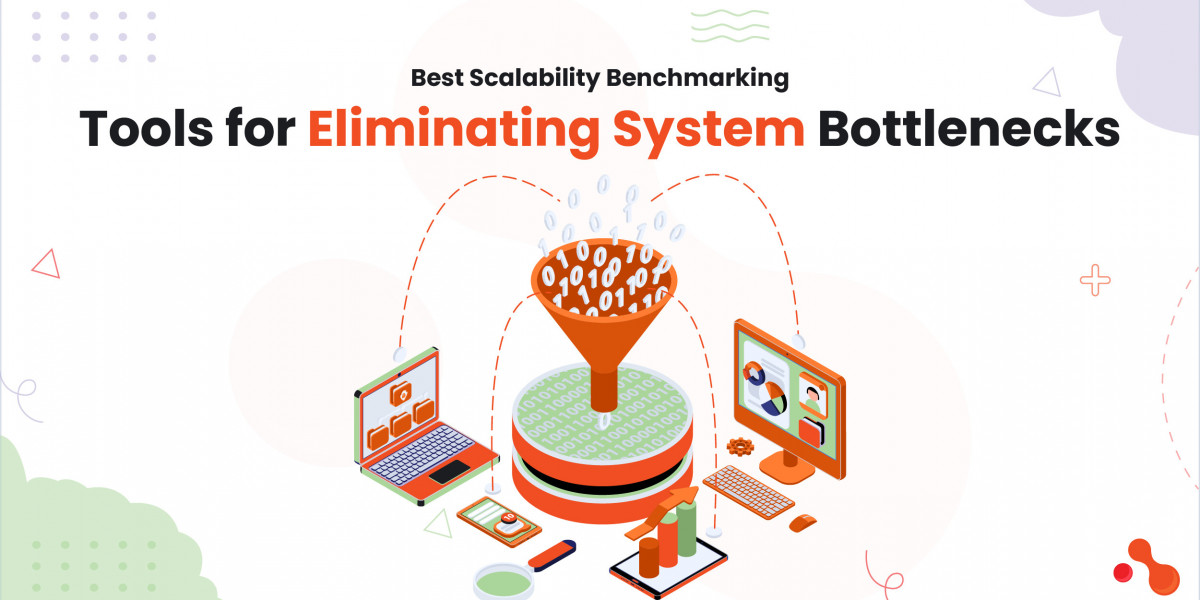Introduction
Scalability benchmarking tools are critical to system handling. They measure overall system performance—how well it keeps up with work overloads. To execute scalability effectively, you must understand the precise details, such as how to handle high-traffic loads effectively.
In this blog, we will uncover the whole scenario for you—from top-rated benchmarking tools to resolving system bottlenecks and adopting staunch software product engineering services for your business.
Let's dive in!
What is System Benchmarking?
Software benchmarking is a process of evaluating your system's overall performance. You can use certain scalability benchmarking tools and services to configure your system's reliability, efficiency, and scalability during peak spikes. It is now a vital aspect for every business, as it helps you understand and align with industry standards.
Scalability benchmarking involves running various system tests to measure its utility under diverse conditions. It helps to identify the improvement areas by comparing against predefined industry benchmarks and systems.
It is important to note that system benchmarking testing differs from standard performance testing.
How? Let's check these pointers mentioned below—
How does System Benchmarking Work?
Major goals of system scalability benchmarking tools and services are to provide a clear objective for measuring the overall system's performance and identify system bottlenecks and behaviors under different conditions.
Here are the steps involved with system benchmarking—
Planning
Involves defining test objectives, KPIs, and benchmark metrics.
Setting up Testing Environment
Creating a controlled prototype environment for testing that resembles the production ones.
Test Execution
To the tests via advanced scalability benchmarking tools and services and collect performance data.
Result Analysis, Comparison, and Reporting
Strategic analysis of the results and reporting them to the development team for further work processes.
Ideal Types Of System Benchmarking
In any standard system performance testing, the system merely aims to verify the basic functionalities of a system. Whereas in system benchmarking, these aspects and types of testing elements are involved—
Performance benchmarks
This testing measures the system's speed and efficiency under typical situations by simulating real-world scenarios.
Load benchmarks
This testing involves measuring how the system performs under diverse user loads during traffic spikes.
Stress benchmarks
Stress benchmarking is putting additional pressure on the system to test its efficiency and operational capacity to figure out its breaking point.
Scalability benchmarks
These benchmarks evaluate a system's behavior and ability to transition under specific conditions.
To make sure the system scales well alongside the increasing market adoptions, it's necessary to utilize top-rated scalability benchmarking tools and services for active system testing. Here we are providing a comprehensive listicle of the best tools that you must adopt—
Best Software Benchmarking Tools for 2025
Apache JMeter
One of the most powerful open-source scalability benchmarking tools, Apache JMeter is utilized widely for precise load and performance testing of systems, APIs, and databases.
Key features of Apache JMeter:
Features a centralized control over multiple loading servers.
- Inbuilt user-friendly GUI allows users to easily create and develop test plans without any extensive scripting.
- Comes with an intuitive interface, load-related metrics, and resource usage for comprehensive performance analysis.
- Multi-protocol support makes the system more versatile for test scenarios.
- Provides real-time testing results in multiple forms of visual charts, tree views, graphs etc., for enhanced system performance analyzation.
- Effortless integration with CI/CD pipelines, Tomcat collectors, and cross-performance testing tools and mechanisms.
- In-depth performance analysis by integrating with Application Performance Management (APM) tools.
Load Runner
It's one of the best scalability benchmarking tools discovered so far for full-scale performance testing and system behavior. Load Runner's special quality includes mimicking virtual users to detect potential bottlenecks within system performance.
Key Features of LoadRunner:
- Features Virtual User Generator (VuGen) to create virtual users by simulating user actions.
- Detailed and precise monitoring tools for complete analyzation of systems, including their resources.
- Robust tests analyze and report features by identifying performance metrics and patterns.
- Ideal for large-scale applications, it supports a wide range of protocols like Web (HTTP/HTTPS), SAP, Oracle, and Microsoft .NET.
- Supports cloud-based load testing and provides real-time test monitoring.
Gatling
It's a free and open-source performance testing framework that effectively simulates user behavior via virtual user creation. Gatling is widely recognized for ensuring a system's high performance by efficient resource utilization.
Key Features of Gatling:
- Asynchronous and non-blocking I/O help systems handle high workloads with limited resources.
- Features Akka toolkit, which supports high volumes of concurrent users, offers seamless data integration.
- Predefined test scenarios in Domain-Specific Language (DSL) make scripts more readable.
- Visually compelling reports and insights delivery for effective performance analyzation and precise identification of system bottlenecks.
- Real-time system monitoring via high-end scalability benchmarking tools and services.
BlazeMeter
A cloud-based load-testing platform for systems to conduct highly scalable, on-demand performance testing. BlazeMeter provides excellent reporting via scalability benchmarking tools for full-fledged performance optimization under various conditions.
Key Features of BlazeMeter:
- Offers highly scalable load generation, enabling testers to simulate large user load volumes from various geographic locations.
- Offers real-time monitoring, reporting, and key performance metrics for identifying system bottlenecks.
- Cross-data access through different resources like TDM database models, spreadsheets, or synthetic data generation.
- Supports all trending and popular scripting languages, including Gatling and Selenium. Apache JMeter, with cloud-based load generation abilities.
- Seamless team management and collaborative features ensure robust cooperation during test creation, analysis, and execution.
NeoLoad
This tool is designed to assess the system's overall performance and scalability. NeoLoad utilizes RealBrowser technology, which enables a more powerful and customized system. It incorporates both browser-based performance and native cloud-based functionality. This scalability benchmarking tool is well known for its user-friendly interface and advanced testing capabilities.
Key Features of NeoLoad:
- Testers can conduct a more simplified test creation with its intuitive GUI.
- Identifying and reports user paths and offers logical actions for complex and real-time work scenarios.
- Scriptless approach and live dashboards with enhanced performance metrics display.
- Cross-team sharing of files, documents, results, reports, and case scenarios.
- Supports a dynamic system infrastructure and scaling ability.
Bottomline
To make your system expand, survive, and adapt to the changing business needs, you must understand the overall concept of scalability benchmarking tools. Scalability is a crucial factor in system architecture, and the right tool stack helps you identify the underlying system bottlenecks and build a reliable system. You must know the dos and don’ts for software scalability with all the details in precise.
You can also scale the system to its best by consulting a software expert, ideally. They can guide you about scalability and its fruitful implementation within the system. You can also get an extended hand to amend quality assurance bottlenecks with scalability testing!
FAQs
How to optimize databases for scalability?
There are many ways to modernize database optimization within a system. It involves certain key strategies, performance and scalability benchmarking tools, and services. You can consult a software expert from a reputed software product engineering company, to know in detail about data optimization-based processes as under—
- Horizontal Scaling/Vertical Scaling
- Data Replication & Caching
- Query and Schema Optimization
- Data Partitioning
- Load Balancing, Monitoring
- Leveraging Cloud Native Solutions
What is the impact of scalability on user experience?
Remarkable!
Scalability causes a system to attain complete transformation based on its business market requirements. There are many ways scalability creates a remarkable user experience impact.
Depending upon your needs, you can make the most out of the system with limited resources, enhancing its efficiency. There are many use cases where businesses adopted certain scalability measures that worked for them to produce a bigger success. You can get to know about such examples of scalability successes vs. failures here.
Original Source of this Blog : https://medium.com/@elijah_williams_agc/best-scalability-benchmarking-tools-for-eliminating-system-bottlenecks-77c87694b35b









